Marius Lindauer
Revisiting Learning Rate Control
Jul 02, 2025Abstract:The learning rate is one of the most important hyperparameters in deep learning, and how to control it is an active area within both AutoML and deep learning research. Approaches for learning rate control span from classic optimization to online scheduling based on gradient statistics. This paper compares paradigms to assess the current state of learning rate control. We find that methods from multi-fidelity hyperparameter optimization, fixed-hyperparameter schedules, and hyperparameter-free learning often perform very well on selected deep learning tasks but are not reliable across settings. This highlights the need for algorithm selection methods in learning rate control, which have been neglected so far by both the AutoML and deep learning communities. We also observe a trend of hyperparameter optimization approaches becoming less effective as models and tasks grow in complexity, even when combined with multi-fidelity approaches for more expensive model trainings. A focus on more relevant test tasks and new promising directions like finetunable methods and meta-learning will enable the AutoML community to significantly strengthen its impact on this crucial factor in deep learning.
Growing with Experience: Growing Neural Networks in Deep Reinforcement Learning
Jun 13, 2025Abstract:While increasingly large models have revolutionized much of the machine learning landscape, training even mid-sized networks for Reinforcement Learning (RL) is still proving to be a struggle. This, however, severely limits the complexity of policies we are able to learn. To enable increased network capacity while maintaining network trainability, we propose GrowNN, a simple yet effective method that utilizes progressive network growth during training. We start training a small network to learn an initial policy. Then we add layers without changing the encoded function. Subsequent updates can utilize the added layers to learn a more expressive policy, adding capacity as the policy's complexity increases. GrowNN can be seamlessly integrated into most existing RL agents. Our experiments on MiniHack and Mujoco show improved agent performance, with incrementally GrowNN-deeper networks outperforming their respective static counterparts of the same size by up to 48% on MiniHack Room and 72% on Ant.
carps: A Framework for Comparing N Hyperparameter Optimizers on M Benchmarks
Jun 06, 2025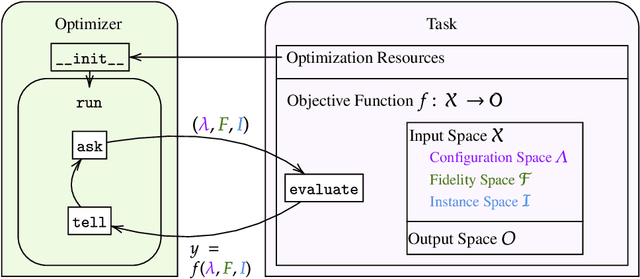


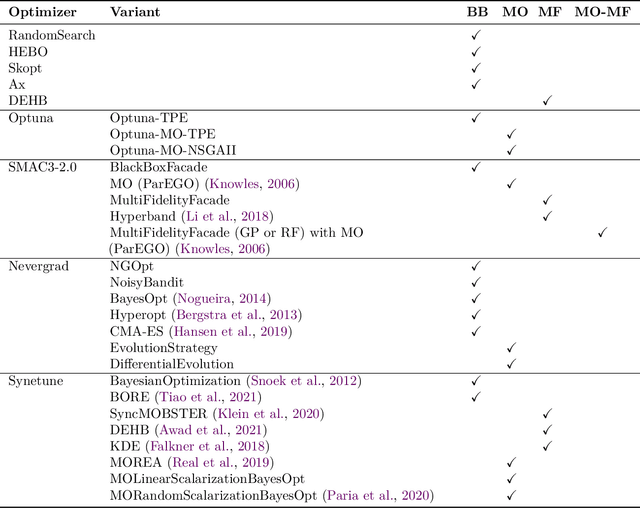
Abstract:Hyperparameter Optimization (HPO) is crucial to develop well-performing machine learning models. In order to ease prototyping and benchmarking of HPO methods, we propose carps, a benchmark framework for Comprehensive Automated Research Performance Studies allowing to evaluate N optimizers on M benchmark tasks. In this first release of carps, we focus on the four most important types of HPO task types: blackbox, multi-fidelity, multi-objective and multi-fidelity-multi-objective. With 3 336 tasks from 5 community benchmark collections and 28 variants of 9 optimizer families, we offer the biggest go-to library to date to evaluate and compare HPO methods. The carps framework relies on a purpose-built, lightweight interface, gluing together optimizers and benchmark tasks. It also features an analysis pipeline, facilitating the evaluation of optimizers on benchmarks. However, navigating a huge number of tasks while developing and comparing methods can be computationally infeasible. To address this, we obtain a subset of representative tasks by minimizing the star discrepancy of the subset, in the space spanned by the full set. As a result, we propose an initial subset of 10 to 30 diverse tasks for each task type, and include functionality to re-compute subsets as more benchmarks become available, enabling efficient evaluations. We also establish a first set of baseline results on these tasks as a measure for future comparisons. With carps (https://www.github.com/automl/CARP-S), we make an important step in the standardization of HPO evaluation.
Auto-nnU-Net: Towards Automated Medical Image Segmentation
May 22, 2025Abstract:Medical Image Segmentation (MIS) includes diverse tasks, from bone to organ segmentation, each with its own challenges in finding the best segmentation model. The state-of-the-art AutoML-related MIS-framework nnU-Net automates many aspects of model configuration but remains constrained by fixed hyperparameters and heuristic design choices. As a full-AutoML framework for MIS, we propose Auto-nnU-Net, a novel nnU-Net variant enabling hyperparameter optimization (HPO), neural architecture search (NAS), and hierarchical NAS (HNAS). Additionally, we propose Regularized PriorBand to balance model accuracy with the computational resources required for training, addressing the resource constraints often faced in real-world medical settings that limit the feasibility of extensive training procedures. We evaluate our approach across diverse MIS datasets from the well-established Medical Segmentation Decathlon, analyzing the impact of AutoML techniques on segmentation performance, computational efficiency, and model design choices. The results demonstrate that our AutoML approach substantially improves the segmentation performance of nnU-Net on 6 out of 10 datasets and is on par on the other datasets while maintaining practical resource requirements. Our code is available at https://github.com/LUH-AI/AutonnUNet.
Guidelines for the Quality Assessment of Energy-Aware NAS Benchmarks
May 21, 2025Abstract:Neural Architecture Search (NAS) accelerates progress in deep learning through systematic refinement of model architectures. The downside is increasingly large energy consumption during the search process. Surrogate-based benchmarking mitigates the cost of full training by querying a pre-trained surrogate to obtain an estimate for the quality of the model. Specifically, energy-aware benchmarking aims to make it possible for NAS to favourably trade off model energy consumption against accuracy. Towards this end, we propose three design principles for such energy-aware benchmarks: (i) reliable power measurements, (ii) a wide range of GPU usage, and (iii) holistic cost reporting. We analyse EA-HAS-Bench based on these principles and find that the choice of GPU measurement API has a large impact on the quality of results. Using the Nvidia System Management Interface (SMI) on top of its underlying library influences the sampling rate during the initial data collection, returning faulty low-power estimations. This results in poor correlation with accurate measurements obtained from an external power meter. With this study, we bring to attention several key considerations when performing energy-aware surrogate-based benchmarking and derive first guidelines that can help design novel benchmarks. We show a narrow usage range of the four GPUs attached to our device, ranging from 146 W to 305 W in a single-GPU setting, and narrowing down even further when using all four GPUs. To improve holistic energy reporting, we propose calibration experiments over assumptions made in popular tools, such as Code Carbon, thus achieving reductions in the maximum inaccuracy from 10.3 % to 8.9 % without and to 6.6 % with prior estimation of the expected load on the device.
AutoML for Multi-Class Anomaly Compensation of Sensor Drift
Feb 26, 2025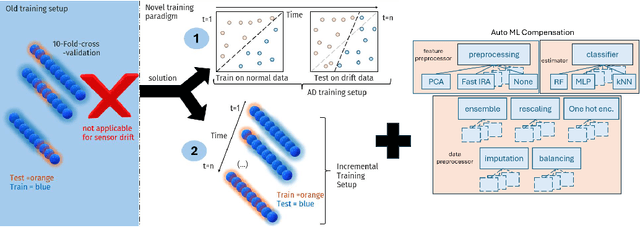
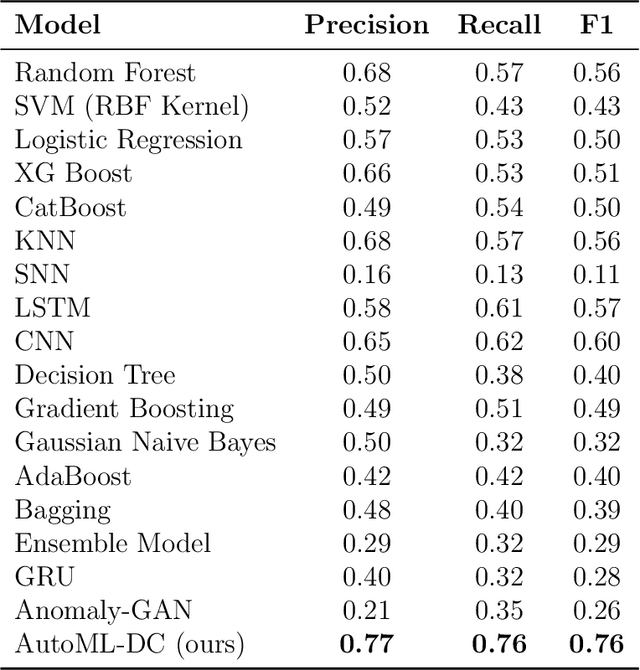
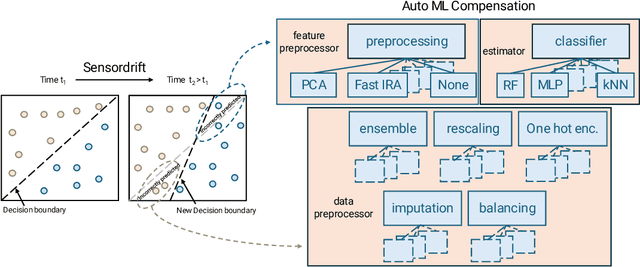
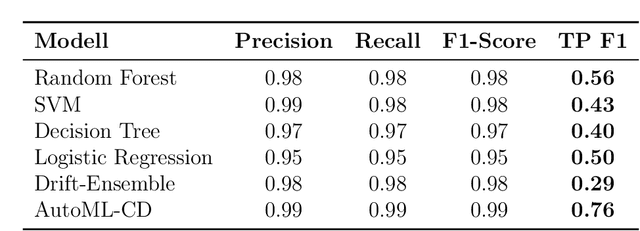
Abstract:Addressing sensor drift is essential in industrial measurement systems, where precise data output is necessary for maintaining accuracy and reliability in monitoring processes, as it progressively degrades the performance of machine learning models over time. Our findings indicate that the standard cross-validation method used in existing model training overestimates performance by inadequately accounting for drift. This is primarily because typical cross-validation techniques allow data instances to appear in both training and testing sets, thereby distorting the accuracy of the predictive evaluation. As a result, these models are unable to precisely predict future drift effects, compromising their ability to generalize and adapt to evolving data conditions. This paper presents two solutions: (1) a novel sensor drift compensation learning paradigm for validating models, and (2) automated machine learning (AutoML) techniques to enhance classification performance and compensate sensor drift. By employing strategies such as data balancing, meta-learning, automated ensemble learning, hyperparameter optimization, feature selection, and boosting, our AutoML-DC (Drift Compensation) model significantly improves classification performance against sensor drift. AutoML-DC further adapts effectively to varying drift severities.
Neural Attention Search
Feb 20, 2025Abstract:We present Neural Attention Search (NAtS), a framework that automatically evaluates the importance of each token within a sequence and determines if the corresponding token can be dropped after several steps. This approach can efficiently reduce the KV cache sizes required by transformer-based models during inference and thus reduce inference costs. In this paper, we design a search space that contains three token types: (i) Global Tokens will be preserved and queried by all the following tokens. (ii) Local Tokens survive until the next global token appears. (iii) Sliding Window Tokens have an impact on the inference of a fixed size of the next following tokens. Similar to the One-Shot Neural Architecture Search approach, this token-type information can be learned jointly with the architecture weights via a learnable attention mask. Experiments on both training a new transformer from scratch and fine-tuning existing large language models show that NAtS can efficiently reduce the KV cache size required for the models while maintaining the models' performance.
HyperSHAP: Shapley Values and Interactions for Hyperparameter Importance
Feb 03, 2025Abstract:Hyperparameter optimization (HPO) is a crucial step in achieving strong predictive performance. However, the impact of individual hyperparameters on model generalization is highly context-dependent, prohibiting a one-size-fits-all solution and requiring opaque automated machine learning (AutoML) systems to find optimal configurations. The black-box nature of most AutoML systems undermines user trust and discourages adoption. To address this, we propose a game-theoretic explainability framework for HPO that is based on Shapley values and interactions. Our approach provides an additive decomposition of a performance measure across hyperparameters, enabling local and global explanations of hyperparameter importance and interactions. The framework, named HyperSHAP, offers insights into ablations, the tunability of learning algorithms, and optimizer behavior across different hyperparameter spaces. We evaluate HyperSHAP on various HPO benchmarks by analyzing the interaction structure of the HPO problem. Our results show that while higher-order interactions exist, most performance improvements can be explained by focusing on lower-order representations.
ARLBench: Flexible and Efficient Benchmarking for Hyperparameter Optimization in Reinforcement Learning
Sep 27, 2024


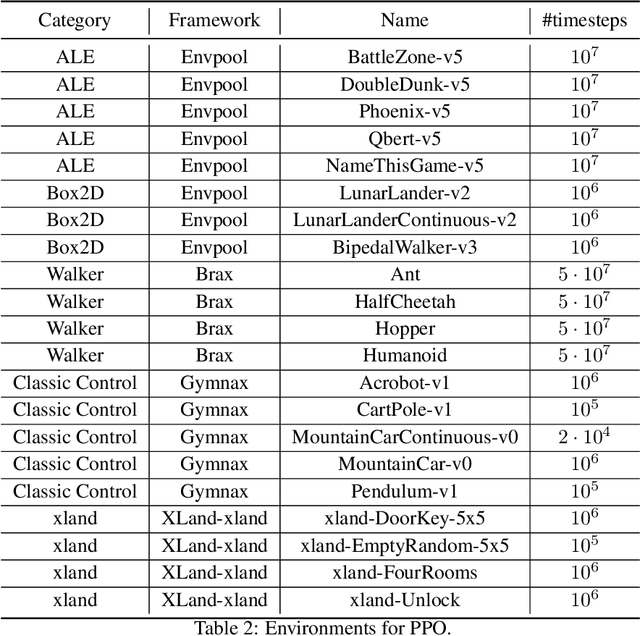
Abstract:Hyperparameters are a critical factor in reliably training well-performing reinforcement learning (RL) agents. Unfortunately, developing and evaluating automated approaches for tuning such hyperparameters is both costly and time-consuming. As a result, such approaches are often only evaluated on a single domain or algorithm, making comparisons difficult and limiting insights into their generalizability. We propose ARLBench, a benchmark for hyperparameter optimization (HPO) in RL that allows comparisons of diverse HPO approaches while being highly efficient in evaluation. To enable research into HPO in RL, even in settings with low compute resources, we select a representative subset of HPO tasks spanning a variety of algorithm and environment combinations. This selection allows for generating a performance profile of an automated RL (AutoRL) method using only a fraction of the compute previously necessary, enabling a broader range of researchers to work on HPO in RL. With the extensive and large-scale dataset on hyperparameter landscapes that our selection is based on, ARLBench is an efficient, flexible, and future-oriented foundation for research on AutoRL. Both the benchmark and the dataset are available at https://github.com/automl/arlbench.
* Accepted at the 17th European Workshop on Reinforcement Learning
Instance Selection for Dynamic Algorithm Configuration with Reinforcement Learning: Improving Generalization
Jul 18, 2024Abstract:Dynamic Algorithm Configuration (DAC) addresses the challenge of dynamically setting hyperparameters of an algorithm for a diverse set of instances rather than focusing solely on individual tasks. Agents trained with Deep Reinforcement Learning (RL) offer a pathway to solve such settings. However, the limited generalization performance of these agents has significantly hindered the application in DAC. Our hypothesis is that a potential bias in the training instances limits generalization capabilities. We take a step towards mitigating this by selecting a representative subset of training instances to overcome overrepresentation and then retraining the agent on this subset to improve its generalization performance. For constructing the meta-features for the subset selection, we particularly account for the dynamic nature of the RL agent by computing time series features on trajectories of actions and rewards generated by the agent's interaction with the environment. Through empirical evaluations on the Sigmoid and CMA-ES benchmarks from the standard benchmark library for DAC, called DACBench, we discuss the potentials of our selection technique compared to training on the entire instance set. Our results highlight the efficacy of instance selection in refining DAC policies for diverse instance spaces.
 Add to Chrome
Add to Chrome Add to Firefox
Add to Firefox Add to Edge
Add to Edge